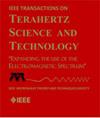毫米波外差光谱超导接收机在尘埃等离子体诊断中的应用
IF 3.9
2区 工程技术
Q2 ENGINEERING, ELECTRICAL & ELECTRONIC
IEEE Transactions on Terahertz Science and Technology
Pub Date : 2024-10-30
DOI:10.1109/TTHZ.2024.3488353
引用次数: 0
摘要
诊断尘埃等离子体中微量成分的物理和化学状态,包括它们的温度和丰度,是一项挑战。本研究利用超导体/绝缘体/超导体接收机和一种新的改进的切轮校正技术,利用0.17 - 0.19太赫兹波段外差光谱测量了电容耦合等离子体(CCP)中形成的HCN谱线。发射光谱测定的N$_{2}$的旋转温度约为310 ~ 380 K,与等离子体气体的动力学温度相似,而HCN的旋转温度约为400 ~ 570 K。这说明观测视场中的HCN在形成过程中含有受溅射、光化学等高能物理过程影响的成分。这种毫米波到太赫兹波段的无源外差光谱技术将为诊断尘埃等离子体的物理和化学状况提供一个有用的工具。本文章由计算机程序翻译,如有差异,请以英文原文为准。
Application of Millimeter-Wave Heterodyne Spectroscopy With a Superconducting Receiver for Dusty Plasma Diagnostics
Diagnosing the physical and chemical states of minor constituents in dusty plasma, including their temperature and abundance, is challenging. In this research, the spectral lines of HCN formed in capacitively coupled plasma (CCP) were measured by 0.17–0.19-THz band heterodyne spectroscopy using a superconductor/insulator/superconductor receiver and a new modified chopper-wheel calibration technique. The rotational temperature of N
$_{2}$
求助全文
通过发布文献求助,成功后即可免费获取论文全文。
去求助
来源期刊

IEEE Transactions on Terahertz Science and Technology
ENGINEERING, ELECTRICAL & ELECTRONIC-OPTICS
CiteScore
7.10
自引率
9.40%
发文量
102
期刊介绍:
IEEE Transactions on Terahertz Science and Technology focuses on original research on Terahertz theory, techniques, and applications as they relate to components, devices, circuits, and systems involving the generation, transmission, and detection of Terahertz waves.
 求助内容:
求助内容: 应助结果提醒方式:
应助结果提醒方式:


